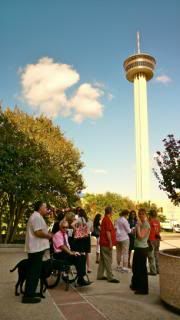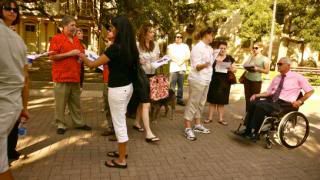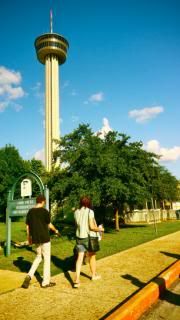Luminaria Arts Night in San Antonio is moving towards its fourth year. I was a participating artist for the first year. I also helped out as a volunteer. The second and third year I sat on the steering committee as co-chair of the film component. For some insane reason I agreed to become involved again for Luminaria 2011. Maybe I agreed because I’m so rarely asked to be a part of something more important than myself. My insecurities are far from inconsequential…in fact, they are quite burdensome. However, the more obvious reason is that Susanne Cooper asked. Susanne, the current co-chair of Luminaria, is someone for whom I have a great deal of respect and fondness. Last year she was the dance co-chair. We bonded over a lunch of fine food and the mutual frustration and resulting commiseration which so often comes out of committee work. We both were thrilled with the several works we were able to foster and bring to stage which fused some delightful collaborations between film and dance. And, so much like my decision to work on Luminaria 2010 because I enjoy working with George Cisneros (co-chair of Luminaria that year), I felt confident that being called back with Susanne at the helm could only be a rewarding experience. It doesn’t hurt that Susanne’s partner in running Luminaria 2011 is Richard Rosen, director of Magik Theatre (he and his Magik crew were crucial in keeping things running smoothly back in March.
There are some fairly significant changes for Luminaria 2011. I suspect I should wait for the upcoming press conference before I mention most of these. But I will say that HemisFair Park is a central part of Luminaria again. This might be because there are plans to bring development to this area of downtown. It seems as though there are two major factions. Those who want a mixed use environment, including residential units. And those who want to retain the original Expo feel of the place, with art and culture remaining at the heart of the place. So, it seems to me, that no matter what one’s agenda, this is an important chunk of real estate which people of diverse desires are horny to showcase. It may well be a perfect storm. We seem to have both political will and commercial will to whore up HemisFair Park come March 2011 with outrageous lighting schemes, three-story macrame spider webs, a poetry slam in the abandoned Women’s Pavilion, fire dancers in the reflecting pools, Caló Kabuki under the clock tower, claymation instructional dental surgery videos projected on the side of the John H. Hood Jr. United States Courthouse building, and the Soli Ensemble playing some discordant atonal opus in the playground behind the historic Kampmann House. And, you know, that’s starting to sound pretty groovy. Cram the sausage-on-a-stick concession in the vestibule of the Universidad Nacional Autonoma (San Antonio campus), and we are good to go. See you then!
[By the way, “Caló” is Chicano slang, basically Pachuconese–and let me just say here that “Pachuconese” is unknown to Google. I claim authorship. R. Erik Bosse, September 15, 2010, originator of the the portmanteau word “Pachuconese.” Fucking A! Urban Dictionary (www.urbandictionary.com), you know where to find me. I’m in the book.]
@@@@@
Here are some photos I took of the Luminaria 2011 steering committee taking a tour of HemisFair Park. I thought it sweet (and, yes, a little weird) that some people brought their dogs.
@@@@@
Noche de Recuerdos is five and a half weeks away. Proyecto Locos is looking for artists to construct floating illuminated altars in the Dia de los Muertos tradition. This has become a major cultural component of this city’s art galleries calendars. Ramon Vasquez y Sanchez (one of the three core members of Proyecto Loco–which also includes Deborah Keller-Rihn and myself, Erik Bosse) brought the Dia de los Muertos altars into the galleries here in the United States back in the seventies. He realized that this important cultural expressions practices amongst Latinos and the indigenous populations had a powerful aesthetic element. And so he invited these folk artists to show their creations at his gallery, Centro Cultural Aztlan. And so now, Proyecto Loco (in association with AIT-SCM, American Indians in Texas, at the Spanish Colonial Missions) have decided to take certain elements from the decorated chalupas (boats) on the Mexican lake of Xochimilco.
For this first year of the event we are starting small. We are asking artists to construct floating altars, which are self-lighted, no longer than eight feet. These mini chalupas will be set afloat on the casting pool of Woodlawn Lake. Perhaps in a year or two the event can be moved to the lake itself, with larger, proper chalupas.
It will be a relaxed night of art, poetry (calaveras), and music provided by some of the local Indian organizations.
It’s an open and inclusive community event, so we’re looking for all sorts of artists. And if you don’t feel like creating something, please come out and join us. It’s free and family friendly!


